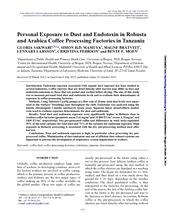| dc.contributor.author | Sakwari, Gloria | en_US |
| dc.contributor.author | Mamuya, Simon H. D. | en_US |
| dc.contributor.author | Bråtveit, Magne | en_US |
| dc.contributor.author | Larsson, Lennart | en_US |
| dc.contributor.author | Pehrson, Christina | en_US |
| dc.contributor.author | Moen, Bente E. | en_US |
| dc.date.accessioned | 2013-10-29T14:30:00Z | |
| dc.date.available | 2013-10-29T14:30:00Z | |
| dc.date.issued | 2013-03 | eng |
| dc.Published | The Annals of Occupational Hygiene 57(2): 173-183 | eng |
| dc.identifier.issn | 0003-4878 | |
| dc.identifier.uri | https://hdl.handle.net/1956/7452 | |
| dc.description.abstract | Introduction: Endotoxin exposure associated with organic dust exposure has been studied in several industries. Coffee cherries that are dried directly after harvest may differ in dust and endotoxin emissions to those that are peeled and washed before drying. The aim of this study was to measure personal total dust and endotoxin levels and to evaluate their determinants of exposure in coffee processing factories. Methods: Using Sidekick Casella pumps at a flow rate of 2l/min, total dust levels were measured in the workers’ breathing zone throughout the shift. Endotoxin was analyzed using the kinetic chromogenic Limulus amebocyte lysate assay. Separate linear mixed-effects models were used to evaluate exposure determinants for dust and endotoxin. Results: Total dust and endotoxin exposure were significantly higher in Robusta than in Arabica coffee factories (geometric mean 3.41 mg/m³ and 10 800 EU/m3 versus 2.10 mg/m³ and 1400 EU/m³, respectively). Dry pre-processed coffee and differences in work tasks explained 30% of the total variance for total dust and 71% of the variance for endotoxin exposure. High exposure in Robusta processing is associated with the dry pre-processing method used after harvest. Conclusions: Dust and endotoxin exposure is high, in particular when processing dry preprocessed coffee. Minimization of dust emissions and use of efficient dust exhaust systems are important to prevent the development of respiratory system impairment in workers. | en_US |
| dc.language.iso | eng | eng |
| dc.publisher | Oxford University Press | eng |
| dc.relation.ispartof | <a href="http://hdl.handle.net/1956/7453" target="blank">Dust exposure and respiratory health among Tanzanian coffee factory workers</a> | eng |
| dc.rights | Attribution-NonCommercial CC BY-NC | eng |
| dc.rights.uri | http://creativecommons.org/licenses/by-nc/3.0/ | eng |
| dc.subject | Coffee dust | eng |
| dc.subject | Coffee processing factories | eng |
| dc.subject | Endotoxin | eng |
| dc.subject | Exposure determinants | eng |
| dc.title | Personal Exposure to Dust and Endotoxin in Robusta and Arabica Coffee Processing Factories in Tanzania | en_US |
| dc.type | Peer reviewed | |
| dc.type | Journal article | |
| dc.description.version | publishedVersion | en_US |
| dc.rights.holder | Copyright the author 2012 | |
| dc.identifier.doi | https://doi.org/10.1093/annhyg/mes064 | |
| dc.identifier.cristin | 1015914 | |
| dc.source.journal | The Annals of Occupational Hygiene | |
| dc.source.40 | 57 | |
| dc.source.14 | 2 | |
| dc.source.pagenumber | 173-183 | |

